Broadband Dielectric Spectroscopy with a Microwave Ablation Antenna
Abstract
1. Introduction
2. Materials and Methods
2.1. Antenna Model and Numerical Simulation Settings
2.2. De-Embedding Models for Reconstructing Dielectric Properties
- capacitance represents the fringing field in the dielectric core of the probe; it is the capacitance between the inner and outer conductor of the probe,
- capacitance represents the fringing field in the outer dielectric material (MUT); capacitance represents the fringing field in free space (when no MUT is located at the probe’s aperture),
- conductance represents the radiation conductance of the probe; conductance is the radiation conductance in free space.
- S&S model
- M&E model
- S&S model
- M&E model
- is the normalized radiation conductance,
- is the difference in reflection coefficients, ρi.j is the measured reflection coefficient when the probe is immersed in one of the known calibration standards (i, j = 1, 2, 3), ρm is the measured reflection coefficient when the probe is immersed in the MUT,
- is the input probe admittance when it is immersed in one of the known calibration standards (j = 1, 2, 3).
- and are the real and imaginary parts of reference complex permittivity of the MUT at the given frequency,
- and are the real and imaginary parts of the calculated complex permittivity, obtained using a specific de-embedding model and a combination of calibration standards.
Dielectric Properties of Selected Materials
- ε∞ is the infinite permittivity (at a very high frequency),
- εs is the static permittivity,
- τ is the relaxation time constant,
- ω is the angular frequency,
- α is an empirical parameter for broadening the dispersion,
- σi is the ionic conductivity,
- ε0 is the permittivity of the vacuum.
3. Results
3.1. Validation of The Numerical Model of the Antenna
3.2. De-Embedding Models’ Comparison
- OC, 0.1 mol and 2 mol NaCl,
- DW, 0.1 mol and 2 mol NaCl,
- DW, 1 mol NaCl and 2 mol NaCl.
- DW, 1 mol NaCl and EG70.
- OC, DW, 0.1 mol and 2 mol NaCl,
- DW, EG70, 1 mol NaCl and 2 mol NaCl,
- DW, EG70, 0.1 mol NaCl and 2 mol NaCl.
3.3. Antenna Sensitivity Analysis
3.3.1. Transversal Dimension Influence
3.3.2. Longitudinal Dimension Influence
3.4. Analysis of the Insertion Depth Influence
4. Discussion
- The optimal de-embedding model and calibration for reconstructing dielectric properties of MUT.
- Sensing region of the antenna.
- Immersion depth limitation.
5. Conclusions
Author Contributions
Funding
Institutional Review Board Statement
Informed Consent Statement
Data Availability Statement
Conflicts of Interest
References
- Bargellini, I.; Bozzi, E.; Cioni, R.; Parentini, B.; Bartolozzi, C. Radiofrequency ablation of lung tumours. Insights Imaging 2011, 2, 567–576. [Google Scholar] [CrossRef]
- Yero, D.D.; Gonzalez, F.G.; Van Troyen, D.; Vandenbosch, G.A.E. Dielectric Properties of Ex Vivo Porcine Liver Tissue Characterized at Frequencies between 5 and 500 kHz When Heated at Different Rates. IEEE Trans. Biomed. Eng. 2018, 65, 2560–2568. [Google Scholar] [CrossRef] [PubMed]
- LoPresto, V.; Pinto, R.; Lovisolo, G.; Cavagnaro, M. Changes in the dielectric properties of ex vivo bovine liver during microwave thermal ablation at 2.45 GHz. Phys. Med. Boil. 2012, 57, 2309–2327. [Google Scholar] [CrossRef] [PubMed]
- Yang, D.; Converse, M.C.; Mahvi, D.M.; Webster, J.G. Measurement and Analysis of Tissue Temperature during Microwave Liver Ablation. IEEE Trans. Biomed. Eng. 2007, 54, 150–155. [Google Scholar] [CrossRef] [PubMed]
- Wessalowski, R.; Schneider, D.T.; Mils, O.; Friemann, V.; Kyrillopoulou, O.; Schaper, J.; Matuschek, C.; Rothe, K.; Leuschner, I.; Willers, R.; et al. Regional deep hyperthermia for salvage treatment of children and adolescents with refractory or recurrent non-testicular malignant germ-cell tumours: An open-label, non-randomised, single-institution, phase 2 study. Lancet Oncol. 2013, 14, 843–852. [Google Scholar] [CrossRef] [PubMed]
- Ahmed, M.; Brace, C.L.; Lee, F.T., Jr.; Goldberg, S.N. Principles of and advances in percutaneous ablation. Radiology 2011, 258, 351–369. [Google Scholar] [CrossRef]
- Fallahi, H.; Prakash, P. Antenna Designs for Microwave Tissue Ablation. Crit. Rev. Biomed. Eng. 2018, 46, 495–521. [Google Scholar] [CrossRef]
- Radosevic, A.; Quesada, R.; Serlavos, C.; Sánchez, J.; Zugazaga, A.; Sierra, A.; Coll, S.; Busto, M.; Aguilar, G.; Flores, D.; et al. Microwave versus radiofrequency ablation for the treatment of liver malignancies: A randomized controlled phase 2 trial. Sci. Rep. 2022, 12, 316. [Google Scholar] [CrossRef]
- LoPresto, V.; Pinto, R.; Farina, L.; Cavagnaro, M. Treatment planning in microwave thermal ablation: Clinical gaps and recent research advances. Int. J. Hyperth. 2017, 33, 83–100. [Google Scholar] [CrossRef]
- Foster, K.; Schepps, J. Dielectric Properties of Tumor and Normal Tissues at Radio through Microwave Frequencies. J. Microw. Power 1981, 16, 107–119. [Google Scholar] [CrossRef]
- Wang, P.; Brace, C.L. Tissue Dielectric Measurement Using an Interstitial Dipole Antenna. IEEE Trans. Biomed. Eng. 2012, 59, 115–121. [Google Scholar] [CrossRef] [PubMed]
- Reimann, C.H.; Bazrafshan, B.; Schubler, M.; Schmidt, S.; Schuster, C.; Hubner, F.; Vogl, T.J.; Jakoby, R. A Dual-Mode Coaxial Slot Applicator for Microwave Ablation Treatment. IEEE Trans. Microw. Theory Tech. 2019, 67, 1255–1264. [Google Scholar] [CrossRef]
- Hessinger, C.; Schüßler, M.; Klos, S.; Kochanek, M.; Jakoby, R. Numerical Optimization of an Open-Ended Coaxial Slot Applicator for the Detection and Microwave Ablation of Tumors. Biology 2021, 10, 914. [Google Scholar] [CrossRef] [PubMed]
- Sawicki, J.F.; Shea, J.D.; Behdad, N.; Hagness, S.C. The impact of frequency on the performance of microwave ablation. Int. J. Hyperth. 2017, 33, 61–68. [Google Scholar] [CrossRef] [PubMed]
- O’Rourke, A.P.; Lazebnik, M.; Bertram, J.M.; Converse, M.C.; Hagness, S.C.; Webster, J.G.; Mahvi, D.M. Dielectric properties of human normal, malignant and cirrhotic liver tissue: In vivo and ex vivo measurements from 0.5 to 20 GHz using a precision open-ended coaxial probe. Phys. Med. Biol. 2007, 52, 4707–4719. [Google Scholar] [CrossRef] [PubMed]
- Yang, D.; Bertram, J.; Converse, M.; O’Rourke, A.; Webster, J.; Hagness, S.; Will, J.; Mahvi, D. A Floating Sleeve Antenna Yields Localized Hepatic Microwave Ablation. IEEE Trans. Biomed. Eng. 2006, 53, 533–537. [Google Scholar] [CrossRef]
- Ehrgott, M. Vilfredo Pareto and Multi-Objective Optimization. Doc. Math. 2012, 8, 447–453. [Google Scholar]
- Stuchly, M.A.; Stuchly, S.S. Coaxial Line Reflection Methods for Measuring Dielectric Properties of Biological Substances at Radio and Microwave Frequencies—A Review. IEEE Trans. Instrum. Meas. 1980, 29, 176–183. [Google Scholar] [CrossRef]
- Marsland, T.; Evans, S. Dielectric measurements with an open-ended coaxial probe. IEEE Proc. H Microw. Antennas Propag. UK 1987, 134, 341–349. [Google Scholar] [CrossRef]
- Deschamps, G. Impedance of an antenna in a conducting medium. IEEE Trans. Antennas Propag. 1962, 10, 648–650. [Google Scholar] [CrossRef]
- Marcuvitz, N. Waveguide Handbook; IEEE Electromagnetic Waves Series; Institution of Electrical Engineers: London, UK, 1986; ISBN 978-0-86341-058-1. [Google Scholar]
- Ruvio, G.; Vaselli, M.; Lopresto, V.; Pinto, R.; Farina, L.; Cavagnaro, M. Comparison of different methods for dielectric properties measurements in liquid sample media. Int. J. RF Microw. Comput. Eng. 2018, 28, e21215. [Google Scholar] [CrossRef]
- Cavagnaro, M.; Ruvio, G. Numerical Sensitivity Analysis for Dielectric Characterization of Biological Samples by Open-Ended Probe Technique. Sensors 2020, 20, 3756. [Google Scholar] [CrossRef]
- Kaatze, U. Complex permittivity of water as a function of frequency and temperature. J. Chem. Eng. Data 1989, 34, 371–374. [Google Scholar] [CrossRef]
- Peyman, A.; Gabriel, C.; Grant, E. Complex permittivity of sodium chloride solutions at microwave frequencies. Bioelectromagnetics 2007, 28, 264–274. [Google Scholar] [CrossRef] [PubMed]
- Vidjak, K.; Farina, L.; Ruvio, G.; O’Halloran, M.; Cavagnaro, M. Ethylene Glycol Based Phantoms for High-Loss and Malignant Tissue at Microwave Frequencies. In Proceedings of the 2023 17th European Conference on Antennas and Propagation (EuCAP), Florence, Italy, 26–31 March 2023. submitted. [Google Scholar]
- Cole, K.S.; Cole, R.H. Dispersion and Absorption in Dielectrics I. Alternating Current Characteristics. J. Chem. Phys. 1941, 9, 341–351. [Google Scholar] [CrossRef]
- Debye, P. Polar Molecules; Dover Publications: Mineola, NY, USA, 1929; Volume 48. [Google Scholar]
- Davidson, D.W.; Cole, R.H. Dielectric Relaxation in Glycerol, Propylene Glycol, and n-Propanol. J. Chem. Phys. 1951, 19, 1484–1490. [Google Scholar] [CrossRef]
- The MathWorks, Inc. MATLAB Website. Available online: https://it.mathworks.com/help/matlab/ref/smoothdata.html (accessed on 5 October 2022).
- Meaney, P.M.; Gregory, A.P.; Seppala, J.; Lahtinen, T. Open-Ended Coaxial Dielectric Probe Effective Penetration Depth Determination. IEEE Trans. Microw. Theory Tech. 2016, 64, 915–923. [Google Scholar] [CrossRef] [PubMed]
- Aydinalp, C.; Joof, S.; Dilman, I.; Akduman, I.; Yilmaz, T. Characterization of Open-Ended Coaxial Probe Sensing Depth with Respect to Aperture Size for Dielectric Property Measurement of Heterogeneous Tissues. Sensors 2022, 22, 760. [Google Scholar] [CrossRef] [PubMed]
- Vidjak, K.; Farina, L.; O’Halloran, M.; Cavagnaro, M. Accuracy of De-Embedding Models for the Open-Ended Coaxial Probe Considering Different Calibration Standards. In Proceedings of the 2022 16th European Conference on Antennas and Propagation (EuCAP), Madrid, Spain, 27 March–1 April 2022; 2022; pp. 1–5. [Google Scholar] [CrossRef]
- Keysight Technologies. Keysight 85070E Dielectric Probe Kit 200 MHz to 50 GHz—Technical Overview; Keysight Technologies: Santa Rosa, CA, USA, 2017. [Google Scholar]
- La Gioia, A.; Santorelli, A.; O’Halloran, M.; Porter, E. Predicting the Sensing Radius of a Coaxial Probe Based on the Probe Dimensions. IEEE Trans. Antennas Propag. 2020, 68, 6704–6716. [Google Scholar] [CrossRef]










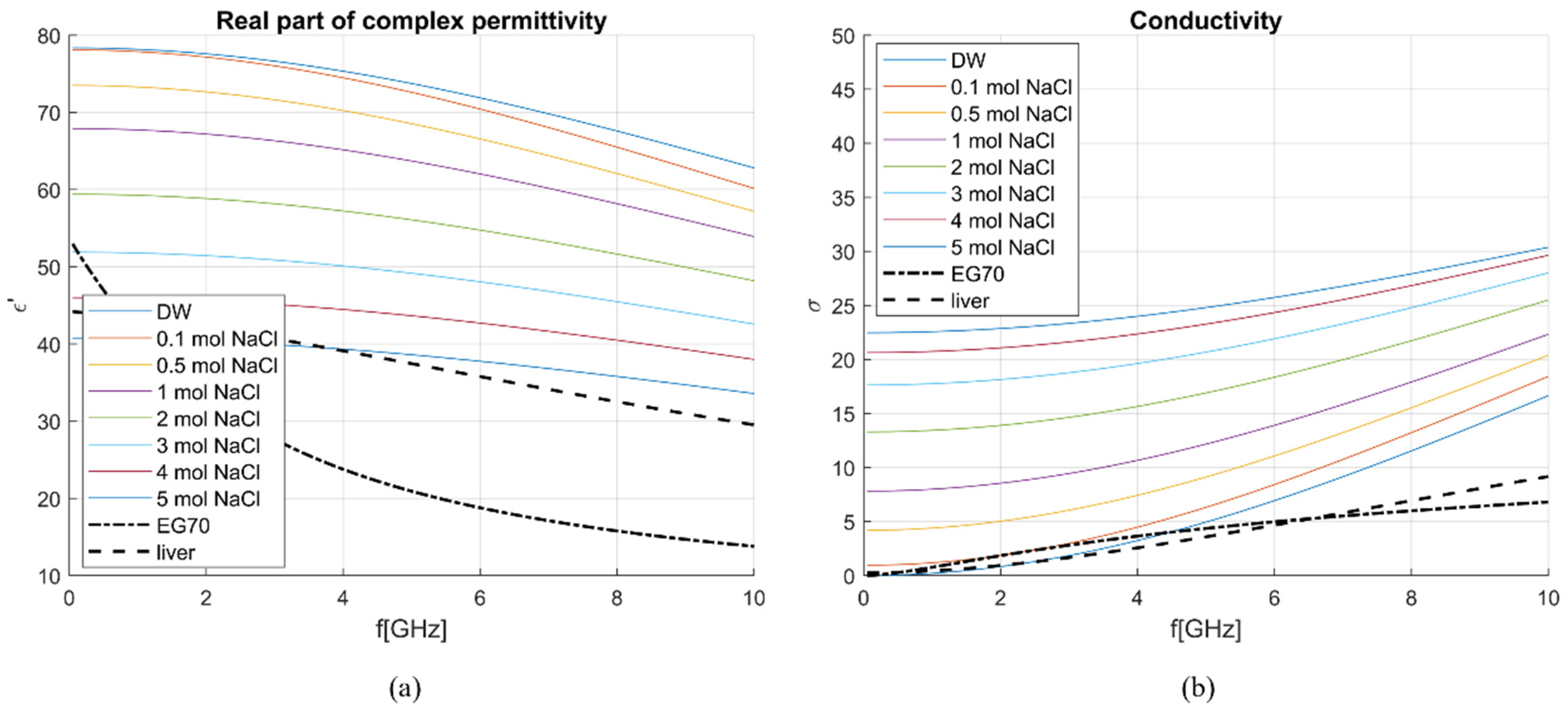



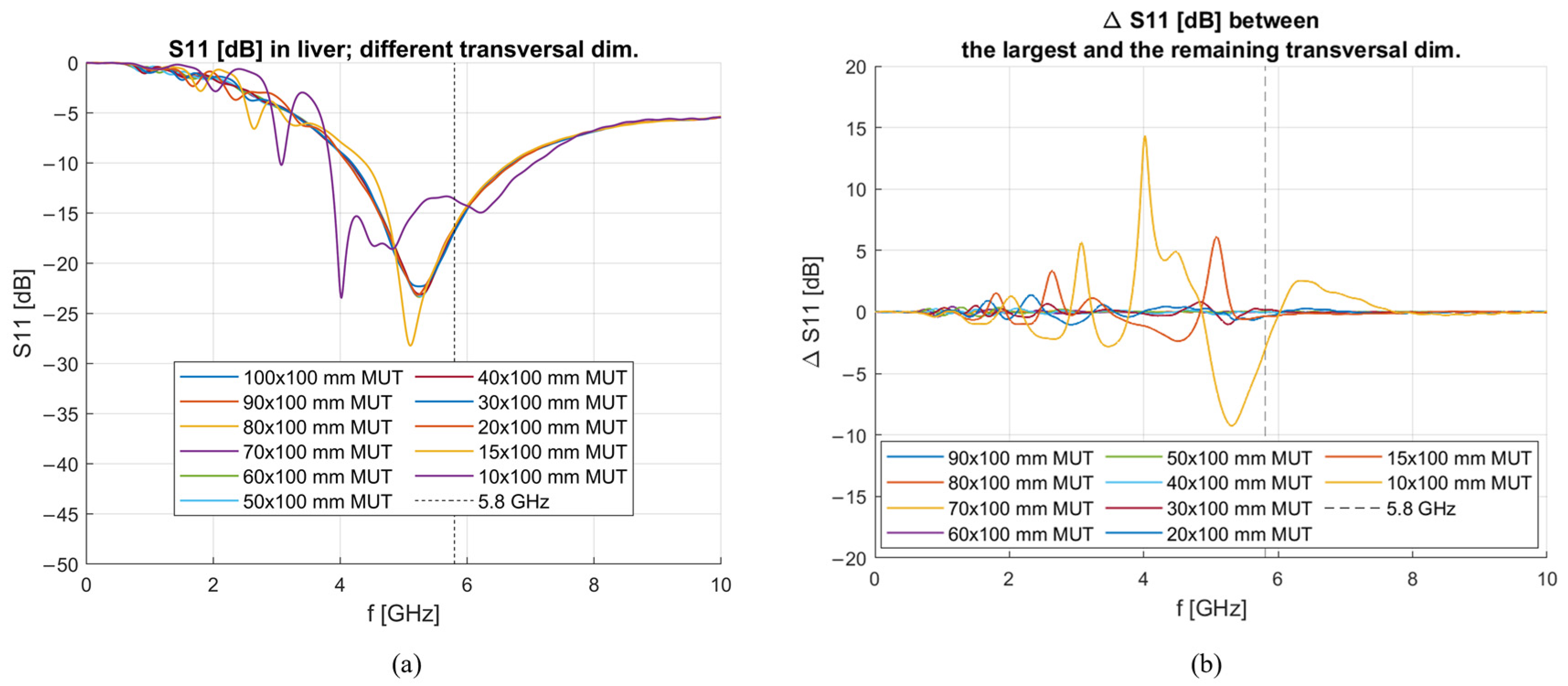
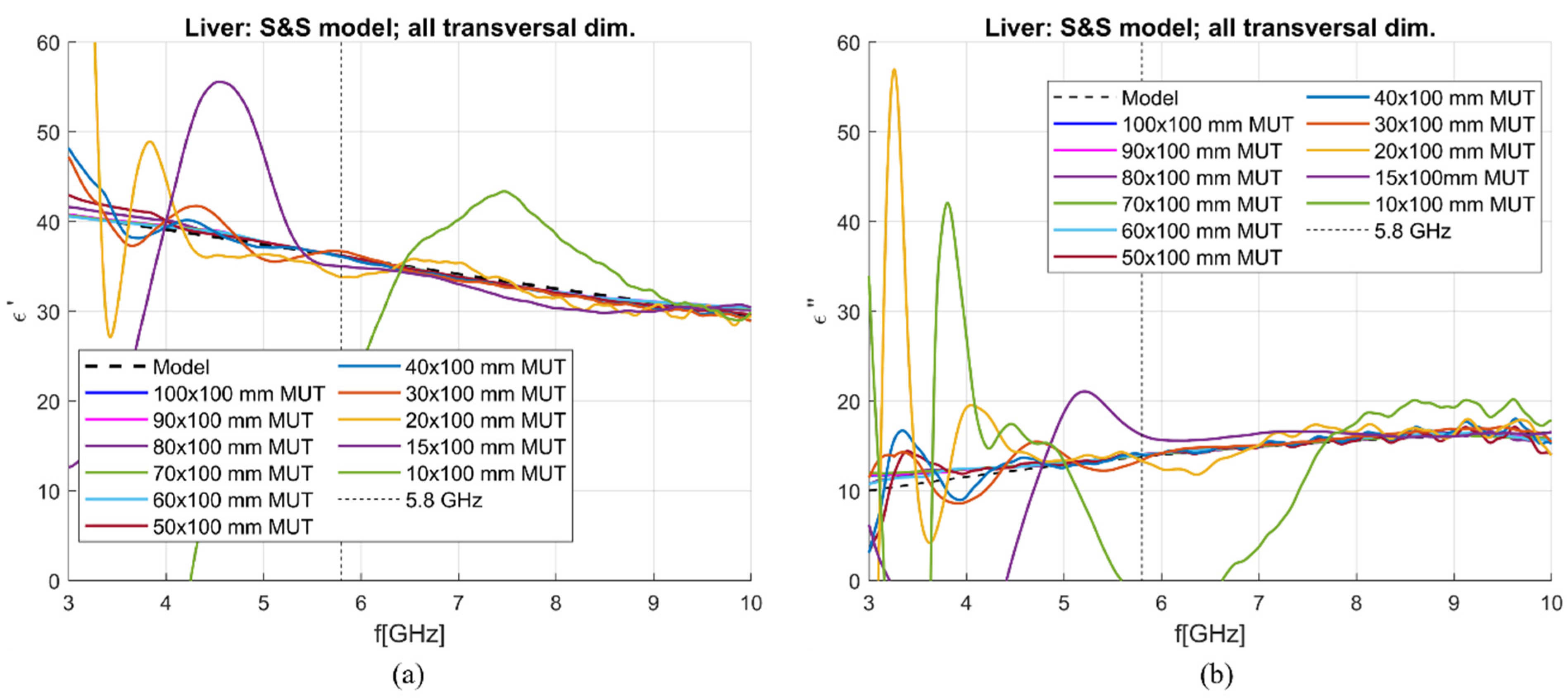
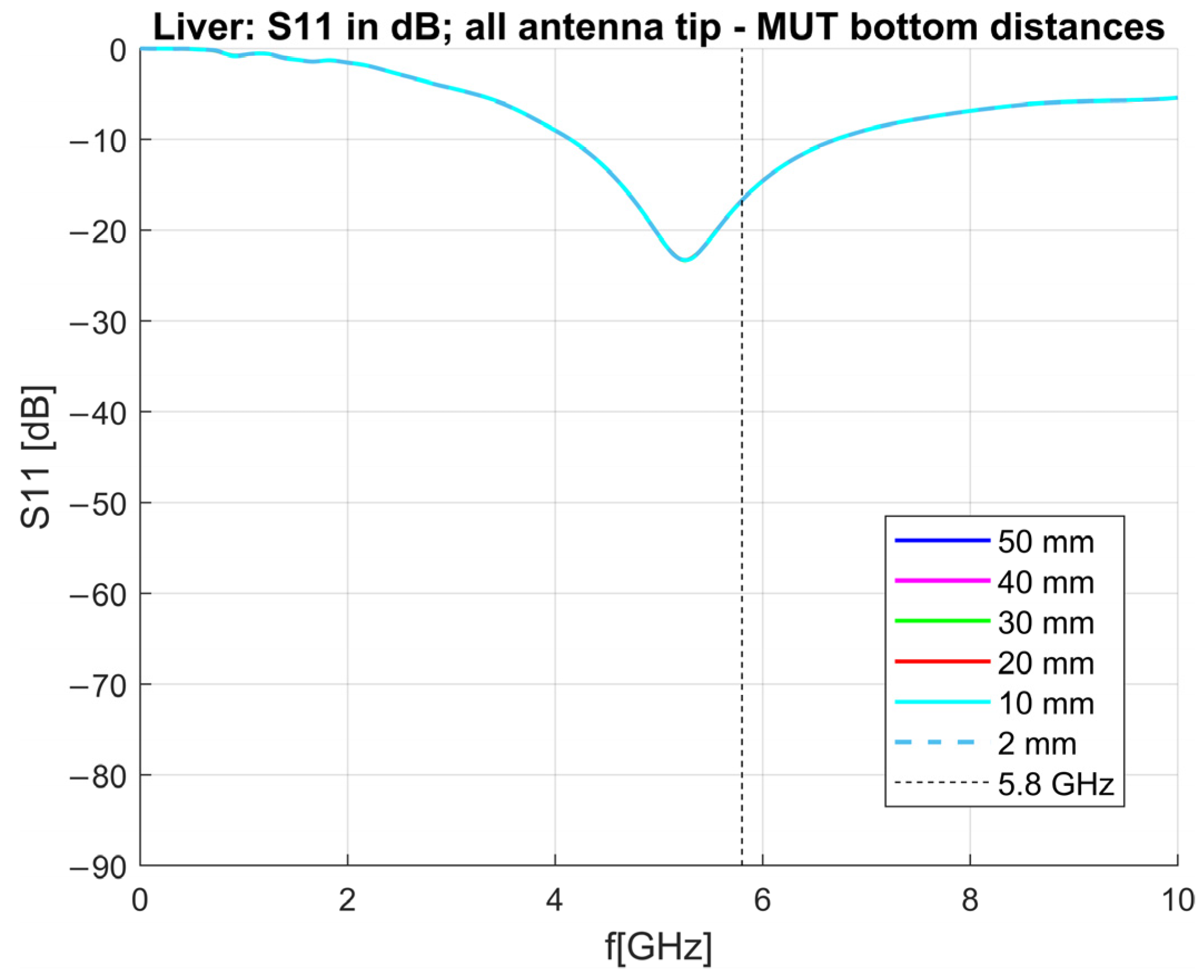

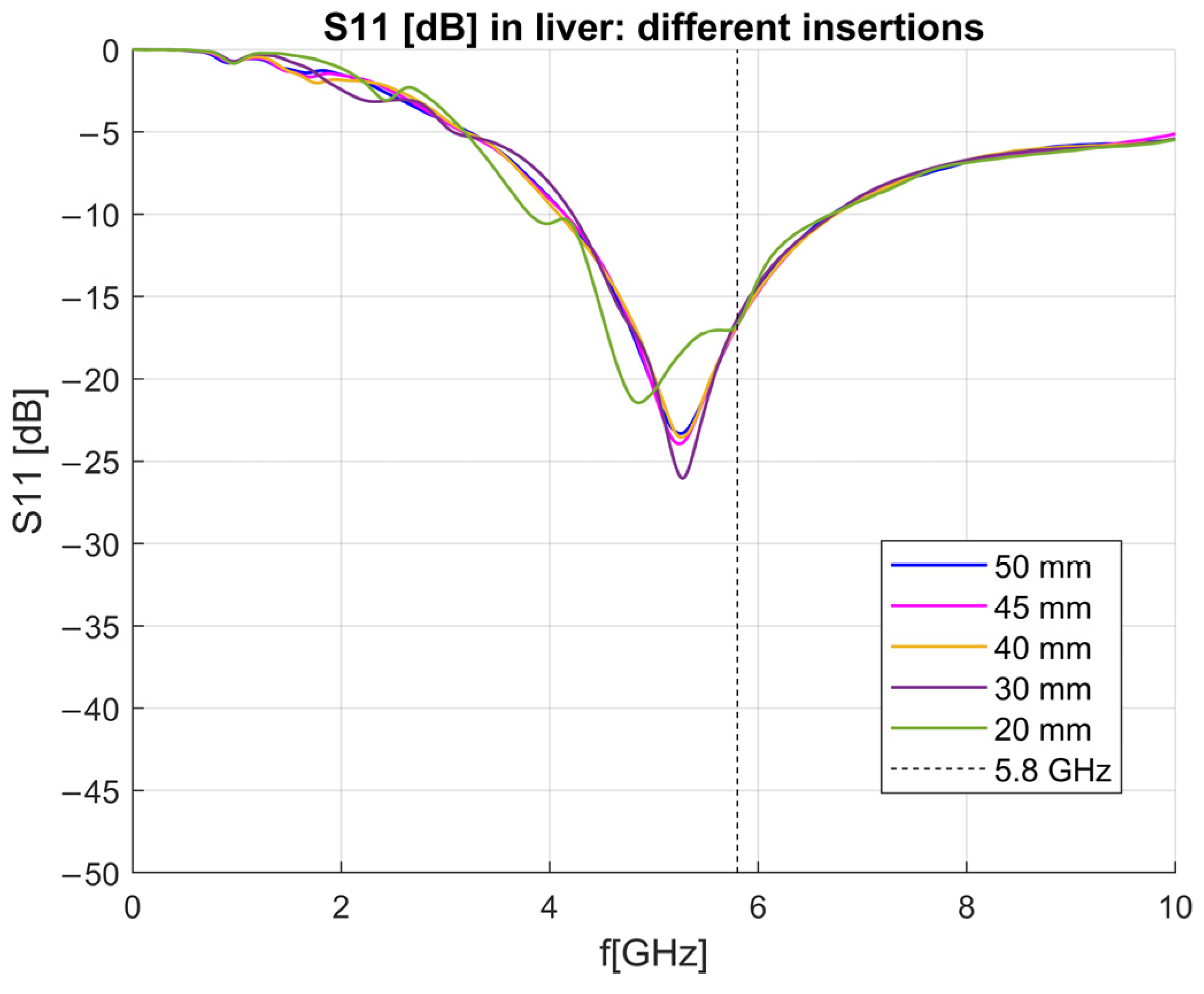
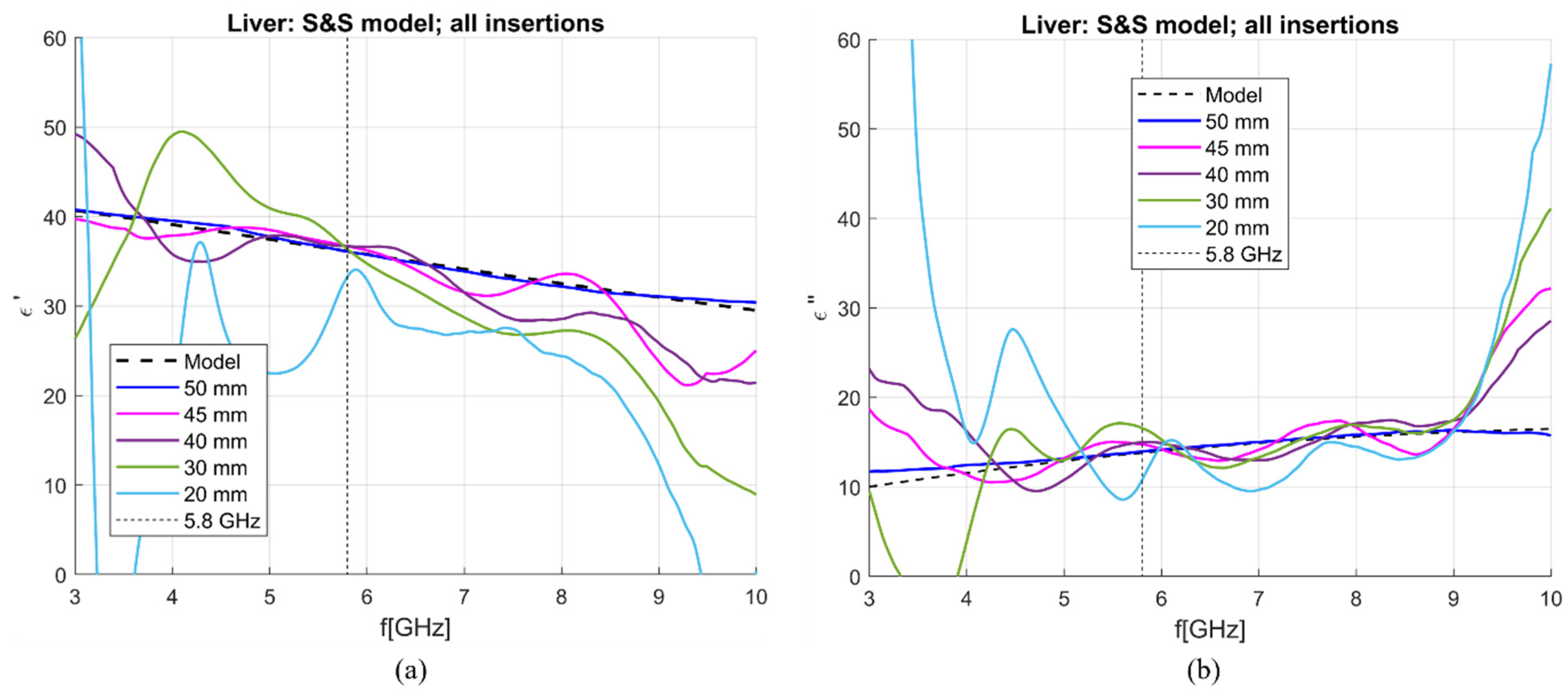
| Design Parameter | Parameter Value [mm] |
|---|---|
| Antenna: structure | |
| 2 | |
| 7.7 | |
| 1.75 | |
| 0.55 | |
| 5.28 | |
| 100 | |
| 50 | |
| Antenna: cross-section | |
| 0.15 | |
| 0.485 | |
| 0.595 | |
| 0.795 | |
| 1.095 | |
| 1.295 | |
| MUT block (cube) | |
| Cube edge | 100 |
| Material | |||||
|---|---|---|---|---|---|
| Liver [15] | 44.32 | 5.32 | 11.55 | 0.25 | 36.115–j13.799 |
| DW at 25 °C [24] | 78.36 | 5.2 | 8.27 | / * | 72.268–j20.213 |
| 0.1 mol NaCl (at 20 °C) [25] | 78.1 | 5.22 | 9.1 | 0.96 | 70.879–j22.071 |
| 1 mol NaCl (at 20 °C) [21] | 67.9 | 5.22 | 8.53 | 7.81 | 62.377–j41.971 |
| 2 mol NaCl (at 20 °C) [21] | 59.4 | 5.22 | 8.13 | 13.29 | 55.028–j55.944 |
| EG70 (at 25 °C) [26] | 53.96 | 3.99 | 58.34 | / * | 19.175–j15.080 |
| Measurement Sensitivity | ||||
|---|---|---|---|---|
| 3–10 GHz Range | @5.8 GHz | |||
| Calibration Option | ||||
| OC, 0.1 mol and 2 mol NaCl | 13.15 | 40.59 | 6.61 | 32.30 |
| DW, 0.1 mol and 2 mol NaCl | 12.95 | 26.11 | 13.52 | 33.13 |
| DW, 1 mol and 2 mol NaCl | 15.44 | 33.84 | 7.57 | 23.22 |
| DW, 1 mol NaCl and EG70 | 0.85 | 3.09 | 0.07 | 1.09 |
| Measurement Sensitivity | ||||
|---|---|---|---|---|
| In the 3–10 GHz Range | At 5.8 GHz | |||
| Calibration Option | ||||
| OC, DW, 0.1 mol and 2 mol NaCl | 12.75 | 20.70 | 13.35 | 11.52 |
| DW, EG70, 1 mol and 2 mol NaCl | 3.28 | 6.61 | 2.46 | 0.14 |
| DW, EG70, 0.1 mol and 2 mol NaCl | 1.48 | 6.57 | 1.42 | 3.20 |
| Measurement Sensitivity | ||||
|---|---|---|---|---|
| In the 5–6 GHz Range | At 5.8 GHz | |||
| 100 × 100 | 0.29 | 1.33 | 0.07 | 1.09 |
| 90 × 100 | 0.30 | 1.26 | 0.04 | 1.02 |
| 80 × 100 | 0.08 | 1.85 | 0.29 | 1.42 |
| 70 × 100 | 0.28 | 1.34 | 0.06 | 1.02 |
| 60 × 100 | 0.28 | 1.46 | 0.10 | 1.56 |
| 50 × 100 | 0.39 | 1.38 | 0.26 | 1.39 |
| 40 × 100 | 0.33 | 1.48 | 0.10 | 1.50 |
| 30 × 100 | 2.13 | 4.74 | 1.56 | 2.55 |
| 20 × 100 | 4.28 | 4.48 | 6.36 | 3.46 |
| 15 × 100 | 6.17 | 37.37 | 3.04 | 17.55 |
| 10 × 100 | 58.22 | 79.88 | 45.76 | 121.88 |
| Measurement Sensitivity | ||||
|---|---|---|---|---|
| In the 5–6 GHz Range | At 5.8 GHz | |||
| Antenna Immersion [mm] | ||||
| 50 | 0.29 | 1.33 | 0.07 | 1.09 |
| 45 | 2.00 | 7.89 | 1.61 | 7.06 |
| 40 | 1.55 | 7.33 | 1.66 | 8.64 |
| 30 | 5.57 | 17.21 | 0.66 | 20.08 |
| 20 | 24.98 | 20.15 | 7.81 | 21.97 |
Disclaimer/Publisher’s Note: The statements, opinions and data contained in all publications are solely those of the individual author(s) and contributor(s) and not of MDPI and/or the editor(s). MDPI and/or the editor(s) disclaim responsibility for any injury to people or property resulting from any ideas, methods, instructions or products referred to in the content. |
© 2023 by the authors. Licensee MDPI, Basel, Switzerland. This article is an open access article distributed under the terms and conditions of the Creative Commons Attribution (CC BY) license (https://creativecommons.org/licenses/by/4.0/).
Share and Cite
Vidjak, K.; Hessinger, C.; Cavagnaro, M. Broadband Dielectric Spectroscopy with a Microwave Ablation Antenna. Sensors 2023, 23, 2579. https://doi.org/10.3390/s23052579
Vidjak K, Hessinger C, Cavagnaro M. Broadband Dielectric Spectroscopy with a Microwave Ablation Antenna. Sensors. 2023; 23(5):2579. https://doi.org/10.3390/s23052579
Chicago/Turabian StyleVidjak, Klementina, Carolin Hessinger, and Marta Cavagnaro. 2023. "Broadband Dielectric Spectroscopy with a Microwave Ablation Antenna" Sensors 23, no. 5: 2579. https://doi.org/10.3390/s23052579
APA StyleVidjak, K., Hessinger, C., & Cavagnaro, M. (2023). Broadband Dielectric Spectroscopy with a Microwave Ablation Antenna. Sensors, 23(5), 2579. https://doi.org/10.3390/s23052579






